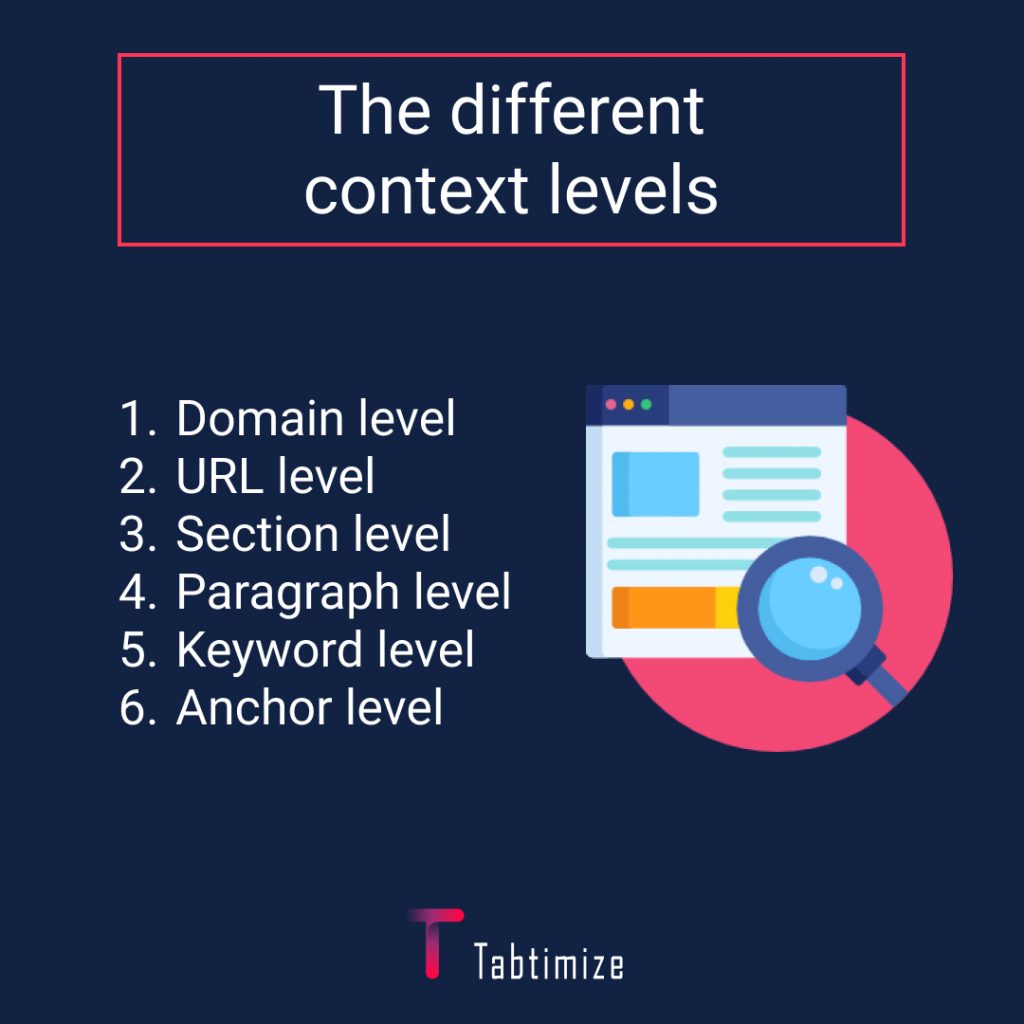A contextual link is a link that relates to the content being targeted as well as the content it has been linked from.
An example could be:
I have a blog post about red apples and somewhere in that post, I mentioned that other types of apples exist, like green apples.
I then link out to a webpage on green apples with the anchor text being “other types of apples exist, like green apples“.
It makes contextually sense from my reader’s perspective to read more about green apples on a webpage about green apples, and because I used an anchor text that also made contextually sense it would be called a contextual link.

What does contextual mean (scientifically)?
Contextual is defined as “something that is or appears to be related to something else or to a specific situation.” Contextual can be used in a scientific setting to refer to a person’s environment or the state of the person’s awareness. Contextual in our “context” is used to describe a link’s relation between its target page and source page.
What are the different types of links?
We are going to look at 5 types of links:
- External Links (backlink)
- Internal Links
- Image link
- Contextual link
- Non-Contextual link
External links are links that point to other websites also known as Backlinks. In this article we look at all types of links, but we have a post just about what a contextual backlink is. These links are important to increase the number of external links to your website, especially search engines like Google use external links for understanding the authority of websites, but they are not as valuable as internal links. And here is why:
Internal links are links that point to other pages on the same website. Internal links are the most valuable type of links because they are the best way to increase your website’s authority, which in turn leads to higher rankings in search engines. Internal links are also the most valuable type of links because they direct people to the most relevant and useful content on your site. So besides its obvious benefit for SEO, it’s also valuable because of its usage in your customer’s journey.
Image links are links that are used in images. This means when you click on an image you will be directed to the target URL of the image link.
A contextual link is as mentioned at the start of the post a link that gives contextually sense from the reader and search engines to follow in regards to its content.
A Non-Contextual link is a type of linking to your website, blog, or other online location that does not add value to the page that it is on. This can include links that simply say “click here” that don’t add any helpful information. So put simply, the totally opposite of a contextual link 🙂
How to define contextuality in links?
Contextuality is a way of understanding the relationship between the links on the web and how those links relate to the context of the content on those pages. Contextuality differs from page rank in that it accounts for all links and other factors and deduces the importance of a page based on the context of those other factors.
It is difficult to define contextuality in links because they are not static. The context is constantly changing.
Contextuality is the relationship between a referring context and its referent as understood by an encoder, decoder, or user. For example, an encoder or decoder can determine whether the text [The dog is said to have eaten the cat] is describing a [dog] that [ate] a [cat], a [cat] that [ate] a [dog], or something else.
Okay to be fair, nobody really does that right? Well, the human brain does it all the time.
But how might a machine like Google and Tabtimize understand contextuality in links? Let’s find out:
Deep dive on the context levels

So firstly we must break down the different layers of contextuality when talking about contextual links.
- Damian
- URL
- Sections
- Paragraph
- Keywords
- Anchor
You have a domain-level context. This is the contextual relation between the two linking domains. So let’s say your site “best-red-apples.com” links out to “all-about-green-apples.io” the machine should try to understand the relation between the two domains.
URL level context. Here we talk about the contextual relation between the two linking web pages. This is properly the most important part of the context layers as it has direct overall importance, whereas the domain level is more out there and keywords/anchors can be slightly less correct.
Section level context. This is typical from one heading to another, normally stretching from one to three paragraphs. So let’s say your section is about “things you didn’t know about our red apples” and the section you linked to is about “facts about green apples”. This would be considered quite relevant.
Paragraph level context. So the machine usually wants to understand the paragraph that the link is sent from to understand the context it should lead to. However, as this could be a couple of words it is sometimes hard for the machine to get enough context to fully understand the right intention behind the link. This is why context levels such as section and URL are important.
Keyword level context. This is typically where the most SEOs focus on and which makes perfect sense, as you want to rank for a keyword right. However, as this is correct for sure, it might not be the most valuable context level to focus your time on. Because as mentioned above getting a link from a page about green apples when you write about red apples is REALLY relevant, because the machine has understood the contextual relation between your link, and of course because the two topics as very similar. But if you didn’t put the link in a relevant URL, in a relevant section of the content, and in a relevant paragraph, that contextual relevancy would decrease and might even give the machine a hard time understanding the true intent behind the link.
Anchor text context level. Anchor texts are what machines like Google in many years have been used as the ultimate classifier for the relevance between two linking pages, which must have changed as NLP has taken over search. Anchor text is still really important when telling the machine and readers what the intent of the link is, but has decreased as the machine now understands the text on a whole new level.
So with the understanding of the different ways search engines understand context, let’s continue on to how they might assess relevance in links.
How does Google determine contextual relevance in links?
Many people use Google to find information about topics they are interested in. The search engine features algorithms that determine the context of the links on the page and uses that information to order the list of results.
Google has never revealed the exact process for determining relevance, but there are many theories about how the algorithm works. One theory is that Google looks for links that are in the same sentence or paragraph as the search term. Another theory is that Google uses the number of links to the page, the number of links to other pages on the site, and the number of times the search term appears on the page.
Google’s algorithm has the potential to be the most powerful search engine in the world. The process of determining relevance is complicated, but the end result is a list of results that are much more relevant to the searcher’s question.
However, there might be a hint to how they do it by looking at how an NLP-based company like Tabtimize looks at relevance in links, as they are using a lot of the same technologies and machine learning algorithms as Google.
How contextual relevance is determined in links
So let get to it.
When Tabtimize has paired you up with a link opportunity they calculate a metric that shows how relevant the two pages are to each other, very simple.
The way it’s done is by analyzing the above-mentioned 6 context levels and providing them with some different scores. The scores are based on content dominance, content relevancy, and content centrality. However, each context level is assessed separately and is assessed differently.
Get a full overview of the different ways Tabtimize looks at these data points.
So based on the different context levels and their importance in terms of SEO, a contextual relevance score (its called Link Relevance Score) is given for the link opportunity.
This is expected by search engines like Google to do more or less in the same way.
Conclusion
So what is a contextual link? Well, it’s a link that makes contextual sense for the site linking out and for the target site. Most importantly it should make sense to the reader.
It can be very difficult to manually assess contextual relevance in links or in link opportunities and therefore it is pretty nice to have a tool like Tabtimize to help you out and do all the assessing for you.



